Case studies are a great way to show how you help your clients. They reassure prospective clients that you can do great work. Further it can help to cement your relationship with the client for whom you did the job. In many proposals, having some good case studies, or project descriptions, is an essential part of a winning proposal.
Yet how many times has a client said to you, “You did good work on this project, but we want you to keep it confidential.” How do you get your client’s buy-in about publishing a case study about your work?
Plant the seed early
When you’re doing the work, mention that you hope to be able to use the work as a case study. Some engineering firms go further – in their standard contract there’s a clause saying that the client will agree to allow information about the project to be made public.
Get your client involved in creating the case study
If you plan to prepare a case study on the project, and maybe get it published, get your user involved in developing the content right from the start. That way they feel a sense of ownership of the case study, and are confident that the content will reflect favorably on them.
Emphasize to your clients that they’ll have opportunity to review the case study before it’s published. Changes can be made as they want, and to stop it dead in its tracks if they want to. It is reassuring to them. To be fair, you wouldn’t want to be putting out a case study if your client objects, right? It sure wouldn't help you get repeat engagements, or referrals to another possible client for you.
Focus on making your client (not just you!) look good
In developing your case study, be sure to avoid anything that sounds like, “My customer was a total basket case. They called to me for help, and so I rode in and saved the day.” Rather, your message should be, “My client was doing well and wanted to do even better. I worked with them to find solutions that helped them meet their goals.”
Make your user the hero of your case study, with you in a supporting role.
If you plan to present the case study for publication, it helps if you focus on media – in print or online – that are relied upon by the customer. Why? Well, for example, if it’s a mining-industry client, an article in a mining publication or a paper presented at a mining conference will give them the adulation of their peers. They’ll probably like that.
If you’re presenting the case study verbally, it helps if you select an event that will have meaning for your client. Not like one of YOUR profession’s conferences or other meetings. Find an opportunity to present at your client’s kind of events. Again, for a mining-sector client, make it a mining industry event. You’ll be more likely to get your client willing to co-present with you. It builds credibility to the story, and your user will appreciate it.
Your client might show their appreciation by introducing you to some of her or his contacts at the event. These newly introduced prospects might become your future clients too.
So, look for ways to build up your client and make them famous. You’ll get to ride along. You might even get more business out of it.
Pictures of work in process really help, whatever the nature of the project. A physical project, like a prototype or an aspect of a civil engineering initiative, can be easily depicted graphically. More ephemeral projects can also be photographed – if it’s a software project, you might take some screen shots of the interface as it grows through development.
Capturing measurements throughout the project can help you build charts and graphs that show how your work has benefited the client.
Take notes – or just record your own comments about the project into a handheld device such as your iPhone or Blackberry, and have those ideas transcribed. It will help you remember the details of the twists and turns on the project, and help avoid errors in the written version of the case study.
Make the project anonymous only if necessary
Your goal should be to produce a case study with details on the project. In some cases, if the customer wants to keep the details anonymous, you may need to “de-clientize” the story. I can’t think of how many times I’ve had to do this. In many instances, a case study I was writing for one of my clients started out with their client’s blessing, but that organization, often via their legal counsel – got cold feet.
I didn't want to kill the story, so prepared a text that told the story, with the details absent or disguised. It would have been much stronger with the client involved, because it indicates that they’re pleased enough with the work to stand behind it, but a de-clientized story is better than nothing.


